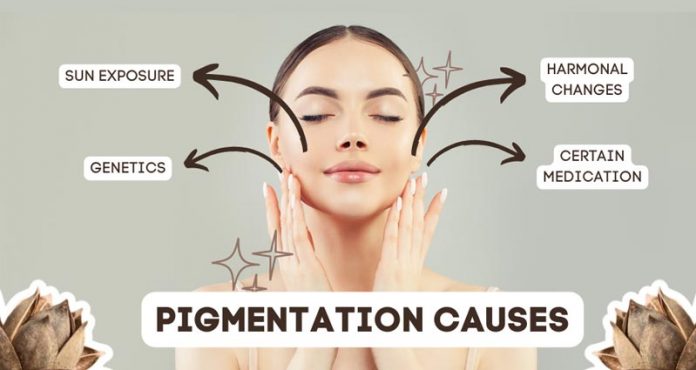Skin Pigmentation refers to a disorder that causes changes to the skin color. Your skin derives its color from a brown colored pigment known as melanin. An individual’s skin tone is determined by the amount of melanin found in it. Therefore, people having dark skin tones have more melanin presence than their counterparts with pale skin color. When the melanocytes, the cells that produce melanin, get damaged, it halts the production of the skin pigment, thereby causing skin pigmentation or skin discoloration. Skin pigmentation can affect your entire body or a small part of the skin, based on the cause behind it and the extent the disorder has progressed.
Types Of Skin Pigmentation Disorders
Skin pigmentation disorders can be classified into three types: hyperpigmentation, hypopigmentation, and depigmentation.
1. Hyperpigmentation Disorder
This skin pigmentation is caused when melanocytes produce a large amount of melanin, making skin look very dark than usual. Excess exposure to sunlight, certain medications, or a few pigmented substances may trigger hyperpigmentation disorder.
2. Depigmentation Disorder
This skin disorder occurs when there is a drastic loss of melanin pigment, which can make the human skin lose its natural shade. Such loss of pigment can be temporary or permanent, with complete or partial melanin pigment loss.
3. Hypopigmentation Disorder
This skin discoloration disorder occurs when melanocyte cells produce a low amount of melanin pigment, making the skin look paler than usual. Skin injuries, such as exposure to strong chemicals and developing a skin infection, ulcers, or burns, can also trigger this primary skin pigmentation disorder. Checkout our article on ways to increase melanin production in the body
List of 5 Common Skin Discoloration Disorders
Skin pigmentation disorders are of various types, each having distinct patterns and symptoms while causing changes in skin color.
1. Albinism
Albinism (1) is a genetic disorder that usually occurs due to the presence of defective genes that hinder the production of melanin pigment. Sometimes, faulty genes can influence how your body produces and distributes the melanin pigment, affecting your skin’s natural color.
Causes of Albinism
- Specific gene mutations or defects that tamper the melanin production in the body.
Symptoms of Albinism
The notable symptom of Albinism is loss of color in eyes, skin, and hair. It can affect the entire skin or a small part based on the extent of the defect in their genes. You might also come across a few individuals with lighter hair, eyes, or skin, indicating Albinism. People with Albinism also experience symptoms like high sensitivity to light, total or partial blindness, involuntary eye movement at a rapid pace, crossed eyes, and more.
Subtypes of Albinism
Genetic defects generally cause albinism and its subtypes.
- OCA or Oculocutaneous Albinism (2) is considered the severe type of Albinism and has several subtypes like OCA1, and OCA2.
- Of these two types, OCA1 is the severe form of Albinism, as a defect in the tyrosinase enzyme causes it.
- OCA2 type is caused when the SLC45A2 protein and TYRP1 gene are affected.
- Ocular Albinism disorder occurs when the X chromosome is mutated, affecting the eyes alone. While the color pigment in the hair and skin remains normal, the retina and the eyes lack pigmentation, leading to vision issues.
- Hermansky-Pudlak Syndrome (3) is connected to OCA and occurs when one of the eight genes responsible for the production of melanin pigment gets affected. It can cause severe effects like large intestine inflammation, pulmonary fibrosis, and blood clots.
Treatment Options for Albinism
Permanent cure for this skin discoloration disorder is still not found. However, with treatment, you can get relief from the severe symptoms. Your healthcare provider will arrive at the right treatment option after analyzing the severity of Albinism.
- It is advisable to protect your skin and eyes from the sun’s harsh rays by wearing sunglasses and sunscreen with a high SPF.
- Your health care specialist would prescribe eyeglasses to improve your vision if required. If you are experiencing rapid eye movements, then an eye muscle correction surgery might be done.
2. Melasma
Popularly known as the pregnancy mask or chloasma, this skin pigmentation disorder affects only women. Melasma (4) is a common skin discoloration disorder that affects humans having a dark skin tone.
Causes of Melasma
- Though the real cause (5) behind this skin discoloration disorder remains unknown, people with high melanocyte activity are prone to develop this condition.
- High sun exposure
- Specific skincare products
- Hormonal changes in women during pregnancies
- Thyroid Imbalance
Symptoms of Melasma
- Gray/brown skin patches of discoloration on the facial skin
- Discoloration on the skin area that is commonly exposed to sunlight
- Symmetrical dark patches on either side of the face or other parts of the body
Treatment Options for Melasma
- If hormonal imbalance triggers Melasma, it will be eliminated as soon as the hormone levels are balanced.
- Topical medications like liquid, lotions, or gels containing Hydroquinone, corticosteroids, and Tretinoin can get rid of the dark patches.
- Specific cosmetic procedures like laser treatments for Melasma(6), microdermabrasion, and chemical peels can be undertaken for cosmetic purposes.
3. Vitiligo
Vitiligo, (7) the chronic skin pigmentation disorder has affected around 2% of the world’s population, equally spreading across every racial group. Study reveals (8) that this skin discoloration disorder is said to have induced psychological distress among the people who have it.
Causes of Vitiligo
- It occurs when melanocytes cells are damaged by the immune system
Symptoms of Vitiligo
- Loss of melanin pigment in the skin causing small or big white patches
- Skin discoloration in arms, feet, eyes, mouth, genitals, head, and groin
- Greying facial hair, eyebrows, and eyelashes
- Discomfort and itching in the white skin patches
- Discoloration in nose lining tissues
Treatment Options for Vitiligo
- Cream with Opzelura or Corticosteroid for restoring pigment
- Light sensitive medicines
- Therapy with UV light
- Surgery to remove the affected skin
4. Acanthosis Nigricans
This hyperpigmentation disorder (9) is an indicator of an underlying health issue. It causes skin discoloration in the skin folds of the nape, groin, and armpit.
Causes of Acanthosis Nigricans
- Insulin resistance
- Obesity
- PCOS, irregular lipid levels, and Cushing Syndrome
- Stomach and other forms of cancer may cause this discoloration
- Genetically inheriting Autosomal dominant trait
Symptoms of Acanthosis Nigricans
- Thick and velvety dark skin patches
- Dry skin on patches
- Itchy skin with tiny blisters
- Skin Tags
Treatment Options for Acanthosis Nigricans
- Blood Tests to identify underlying medical conditions
- Medications with corticosteroids, and nicotinic acid
- Hormone therapy
5. Xeroderma Pigmentosum
It is an inherited disorder that makes the person highly sensitive to UV light. The DNA cells in people affected by Xeroderma pigmentosum (10) condition gets damaged and doesn’t get repaired automatically as in normal people. These affected DNA can harm the eyes and skin of the individual.
Causes of Xeroderma Pigmentosum
- It is inherited by autosomal recessive pattern
- It occurs when DNA is damaged by UV light
Symptoms of Xeroderma Pigmentosum
- Severe sunburns with blistering even if the skin is exposed to sunlight briefly
- Sunburn takes several weeks to heal
- Developing several freckles at a young age
- A very dry skin condition called Xerosis
- Developing solar keratosis, which is skin growth with a rough surface
Treatment Options for Xeroderma Pigmentosum
- Taking measures to avoid UV exposure during the daytime
- Using broad-spectrum sunscreen once in two hours
- Regular Vitamin D supplements
- Total body exams and skin examinations Oral medications with isotretinoin to treat skin cancer
- Eye drops for preventing eye problems
Conclusion
There are proven procedures to cure noncritical skin pigmentation available with Kolors skin clinics. Their treatment options help remove the formation of melanin and helps lighten the skin tone. The expert at Kolors will examine the pigmentation site and advice on the treatment procedure. For example, the treatment might include using chemical peels to remove melanin build-up and pigment formation. As a result, you can once again have brighter skin post-treatment. Besides, the expert can advise on customized treatment options for long-lasting results.
Skin Pigmentation Or Skin Discoloration FAQs
Can you prevent skin pigmentation?
Skin pigmentation disorders that are caused due to a genetic component cannot be prevented. However, protecting the skin from the sun and taking good care of the skin to avoid damage can reduce the risk of developing a few types of skin pigmentation. In addition to sun exposure, birth control pills and hormone imbalance could also cause diseases like melasma. One should always use sunscreens to avoid skin damage due to the sun. Laser treatment and chemical peels could also help eliminate a few types.
What is the impact of skin pigmentation disorders on an individual’s life?
Skin pigmentation disorders can cause psychological and emotional impacts on a person’s life. For example, they can cause social anxiety and self-consciousness and, in some cases, might also cause depression. Therefore, in addition to managing the physical aspect of the disorder, one should also get help to manage the emotional side of it.
Are skin pigmentation disorders permanent?
All types of skin pigmentation disorders are not permanent. Post-inflammatory hyperpigmentation can fade with time once the inflammation subsides. Over-the-counter medications or prescription lightening creams may decrease the time it takes to fade the area. Vitiligo or melasma, on the other hand, requires ongoing treatment.
Can one hide pigmentation by makeup?
Yes, cosmetics can be used to cover areas of skin discoloration. However, one should always make it a point to use only non-comedogenic or hypoallergenic products to avoid skin irritation.
Are skin pigmentation disorders contagious?
No, skin pigmentation disorders are neither life-threatening nor contagious.
Reference
- https://medlineplus.gov/ency/article/001479.htm
- https://medlineplus.gov/genetics/condition/oculocutaneous-albinism/#causes
- https://rarediseases.info.nih.gov/diseases/6643/hermansky-pudlak-syndrome
- https://www.aad.org/public/diseases/a-z/melasma-symptoms
- https://www.aad.org/public/diseases/a-z/melasma-causes
- https://www.aad.org/public/diseases/a-z/melasma-treatment#causes
- https://www.sciencedirect.com/science/article/pii/S2352647517300965?via%3Dihub
- https://journals.sagepub.com/doi/10.4103/0253-7176.135385
- https://www.aad.org/public/diseases/a-z/acanthosis-nigricans-symptoms
- https://rarediseases.org/rare-diseases/xeroderma-pigmentosum/









